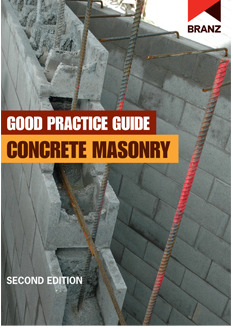
Good Practice Guide: Concrete masonry (2nd edition)
Product Description
Single-skin masonry construction has a small but significant share of the New Zealand construction industry. It is seen as a robust construction system where the structural and weathertightness functions of a wall are carried out by a single construction element.
The guide covers performance requirements, design and detailing requirements, material selection, good construction practices, weathertightness and maintenance. It is well illustrated with photographs and three-dimensional drawings to explain the requirements of single-skin masonry from initial design requirements through to the weatherproof coating options.
This guide is an essential reference for designers and specifiers, masons, building contractors, building officials, and tutors and students of construction-related disciplines.
Disclaimer: Please note that our publications reflect the regulations and best practices on the date of release, which is shown on the publication. As regulations and industry standards evolve, we always recommend that our publications be read in conjunction with the latest building code clauses and standards.
| Publication date | 1 June 2014 |
|---|---|
| Author | Trevor Pringle |
| Product type | Book |
| Availability | Available |
| Product code | BK115 |